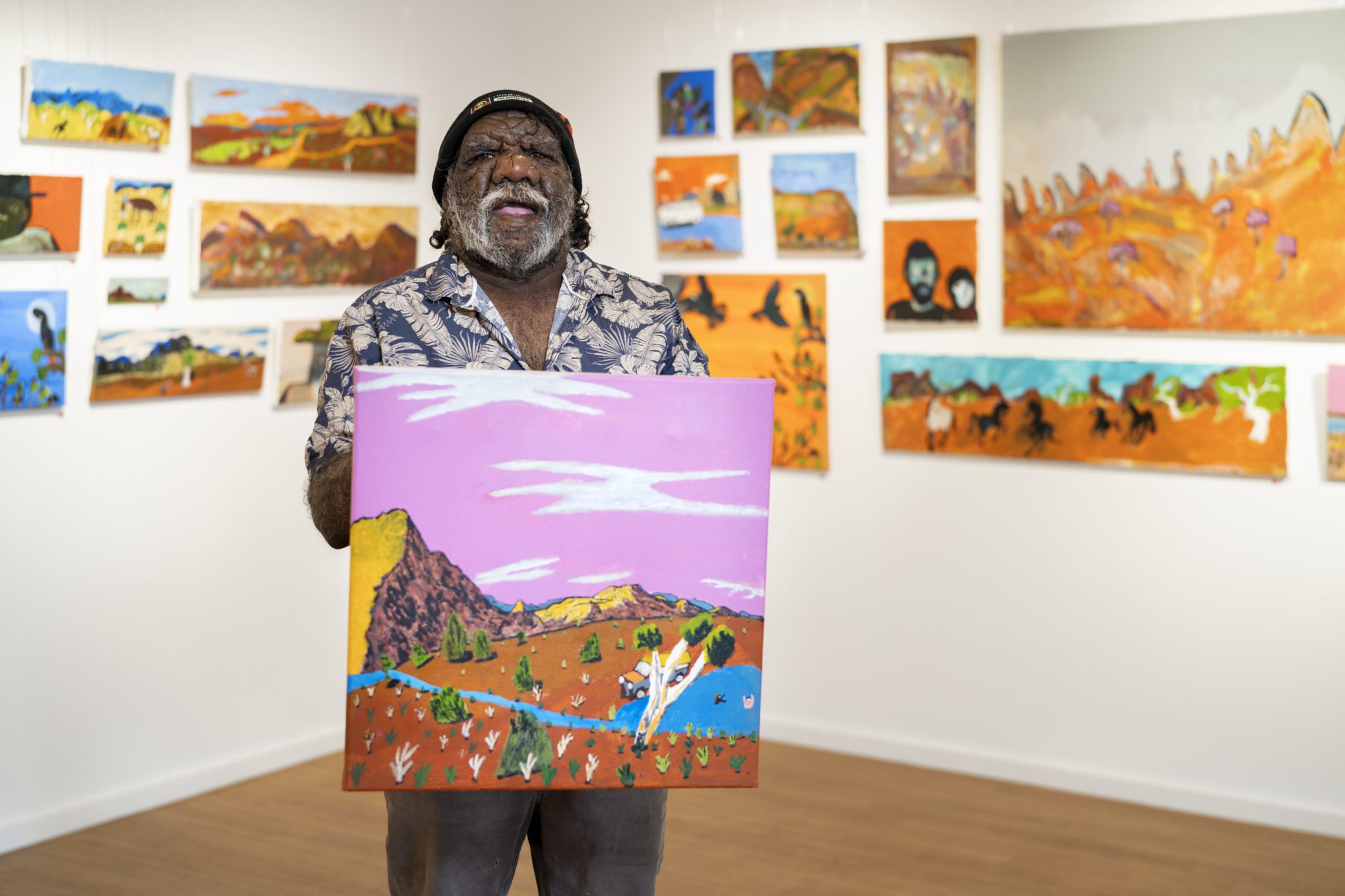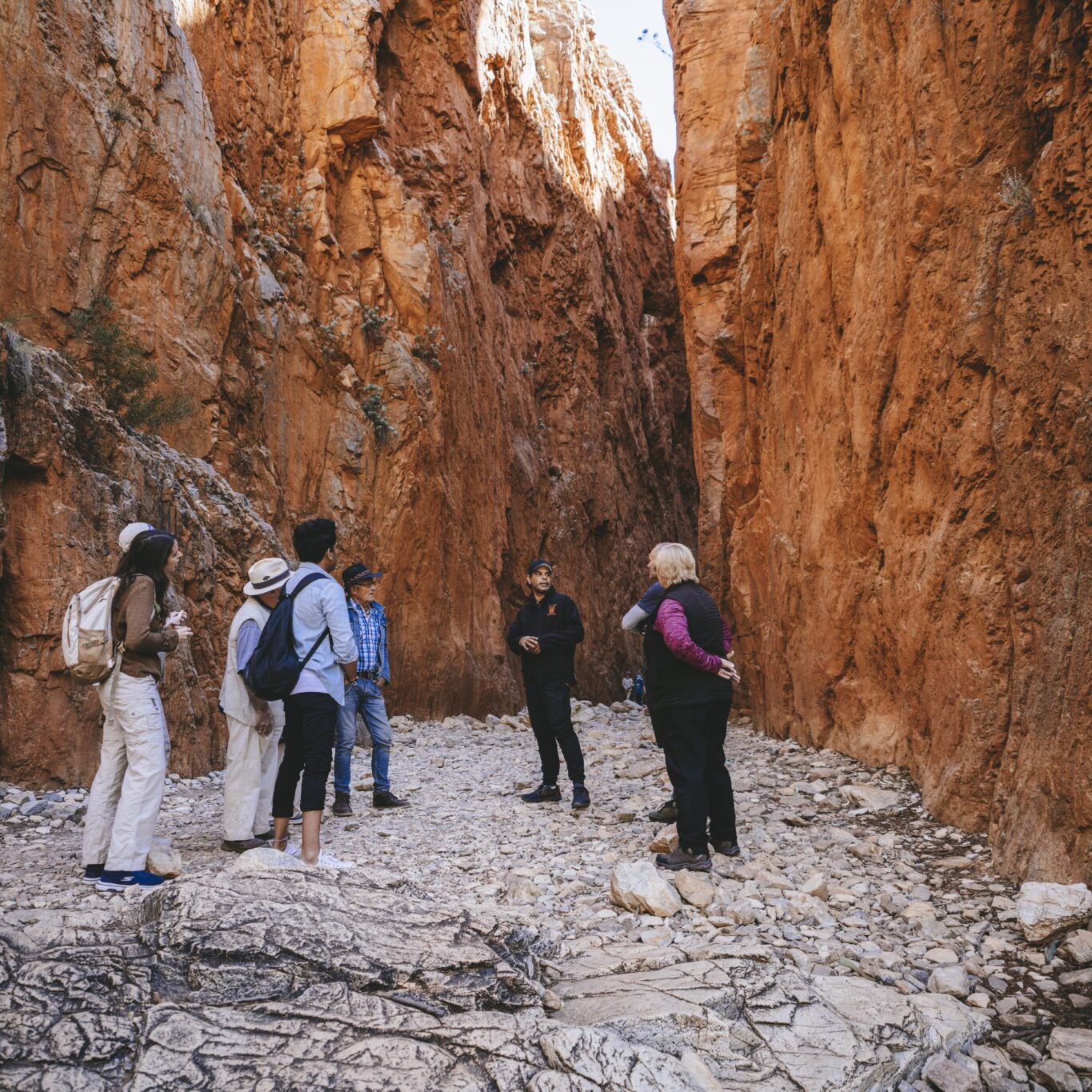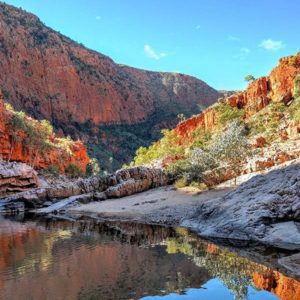This town at Australia’s Red Heart is a holder of the heritage of the world’s oldest living culture. Here’s how to experience it before or after your adventure on the Larapinta Trail.
Mparntwe, as the local Arrernte people call Alice Springs, sits in the midst of a landscape thousands of years in the making. They believe it was created by their ancestors, caterpillar beings known as Ayepe-arenye, Ntyarlke and Utnerrengatye. Now, the town itself blends traditional culture with a more modern sensibility. About 25 percent of the population of Alice Springs speaks Arrernte as their first language, and there is a wealth of outstanding Indigenous experiences for visitors to explore. These are seven of our favourites.
1. If you’re short on time, immerse yourself in the significant artistic, cultural and historical experiences at Araluen Cultural Precinct. Consisting of four museums and the Araluen Arts Centre, it hosts a program of film, theatre, comedy, circus, music and, of course, art. The Araluen Collection has more than a thousand artworks from Aboriginal and Australian creators that bring together a permanent record of the arts practices of Central Australia. Around the precinct, you’ll discover public art, including Clifford Possum’s mural. Look out for the old corkwood tree, one of the seven sacred sites in the precinct.

Credit: Tourism Australia
2. More than 400 female artists from 26 remote communities across the Central and Western Desert regions are represented by Tjanpi Desert Weavers, a not-for-profit Aboriginal social enterprise of the Ngaanyatjarra Pitjantjatjara Yankunytjatjara (NPY) Women’s Council. Here, they create incredible pieces of contemporary fibre art using native grasses. The art gallery in Alice Springs gives visitors the chance to view and buy baskets, sculptures and jewellery.
3. Head 40 kilometres south of town to the Napwerte/Ewaninga Rock Carving Conservation Reserve and explore the petroglyphs (rock engravings) made by early Arrernte people. Follow a 680-metre walking trail to a clay plan where the engravings can be viewed. Each depicts a symbol or motif, some of them sacred and the meanings of which are guarded by Arrernte men. Hot tip: visit in the early morning or late afternoon when the shadows make the petroglyphs more visible.
4. In the year 2000, the Bindi Mwerre Anthurre Artists studio was formed to give Aboriginal artists living with a disability the chance to develop their practice and show it to the wider community. It provides studios, collaborations and a national exhibition schedule and offers these artists the chance to take part in art fairs and awards. Take the 20-minute walk from the town centre to the Bindi Gallery, where you can view the distinctive, sought-after figurative and landscape works, which reflect the region as seen by their makers. If you’re keen on visiting the artists at work in the studio, ring beforehand to make an appointment.
5. Join the half-day Angkerle Cultural Experience, where Western Arrernte people, traditional owners of this land, lead a walk exploring Standley Chasm, known as Angkerle Atwatye. Find out about the flora and fauna of this spectacular landmark, where red cliffs soar into the sky, as well as bush medicine, weaponry, bush tucker and the spiritual connection the Arrernte people have to this place. You’ll also test your dot painting skills while creating your own souvenir.
6. In 1877, Lutheran missionaries arrived at a sacred site known as Ntaria and called it Hermannsburg after their home in Germany. At first, they had no contact with the Arrernte people, but gradually established contact. Eventually, the mission became a settlement, where Aboriginal people lived and practised the Lutheran faith, and several missionaries documented the Arrernte language. Many people know it as the birthplace of famous painter Albert Namatjiri, and in 1982 the land and the buildings on it were returned to traditional ownership. The Hermannsburg Historic Precinct now consists of 16 significant building and a cemetery, and is considered one of the most important heritage sites in the Northern Territory. About 600 people still live in the town of Hermannsburg, most of them Indigenous, and many artists, including the Hermannsburg Potters, still practise here.

Credit: Tourism Australia
7. When you’re ready to explore further, sign up for a day out at Karrke Aboriginal Cultural Experience & Tours, about 300 kilometres from Alice Springs. Find out plenty about the bush tucker used for both food and medicine by the Luritja and Pertame (Southern Arrernte) people. If you’re ready to tuck in, you won’t be disappointed, with a selection of seasonal bush tucker, including witchetty grubs, served up beneath shady trees. You’ll also see edible seeds from trees and grass being ground, and hear a detailed explanation of Aboriginal dot painting. The tours take place Wednesday to Sunday from February to October.
Ready to experience Alice Springs and its surrounds in person?
Check out our upcoming Larapinta adventures:
Lung Foundation Australia – Larapinta Trek
Indigenous Literacy Foundation – Larapinta Trek
WWF Australia – Larapinta Trek
Cystic Fibrosis Western Australia – Larapinta Trek
Choose your charity – Larapinta Trek
Cancer Council Victoria – Larapinta Trek
COMING SOON: National Breast Cancer Foundation (NBCF) – Larapinta Trek
DeadlyScience – Larapinta Trek
Killara Foundation – Larapinta Trek
Muscular Dystrophy NSW – Larapinta Trek
Ovarian Cancer Australia – Larapinta Trek
Imbumba Foundation – Larapinta Trek
Liked this article? Here's some more you might like:
















